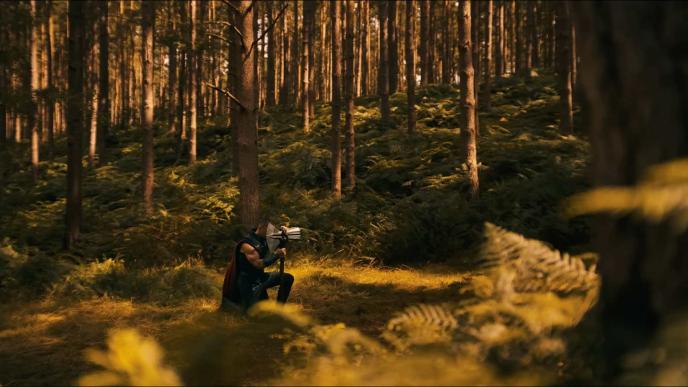Avatar
Framestore is delighted and honoured to be the only UK facility awarded shots on James Cameron's Avatar, undoubtedly the most eagerly anticipated movie event of 2009, if not the decade. Produced by Cameron's own Lightstorm Entertainment, Avatar opened on 17th December 2009 in the UK and 18th December in the US, and was released in 2D and 3D formats, along with an IMAX 3D version.
Cameron, the writer/director of such milestone films as Terminator, Aliens and Titanic, first conceived this epic sci-fi fantasy some fourteen years ago but had to wait, as he says, for the technology to catch up with his imagination. In 2005 it did, and he's been working non-stop on the project ever since. Avatar is without doubt the most demanding visual effects film project yet created. A photorealistic CGI spectacular featuring live human actors performing in almost entirely CG environments, as well as a supporting cast of CG alien beings, the film also marks a breakthrough in terms of filmmaking technology, with its development of 3D viewing and stereoscopic filmmaking using cameras that were specially designed for the production under Cameron's personal supervision.
Avatar tells the story of an epic conflict on a far-away world called Pandora, where humans and the native species of Pandora, the Na'vi, engage in war over the planet's resources and existence. Jake Sully (Sam Worthington) is a crippled marine who becomes the film's reluctant hero, embarking on a journey of redemption and discovery as he leads a battle to save a civilization.
Bid For Glory
After an initial approach by Avatar VFX Producer Joyce Cox in December 2008, Framestore bid on a substantial tranche of shots that would give the company a chance to play to some of its technical strengths in visual effects whilst also offering its artists and technicians an opportunity to get their feet wet in the new wave of 3D film technology.
The shots won by Framestore cover three key sequences within the film:
- the first showing Sully's arrival on Pandora, at the military-industrial landing field known as Hell's Gate
- the second taking place within the Armor Bay, an enormous fortified hangar adjacent to the landing field, during which Sully converses with the film's primary antagonist, Colonel Miles Quaritch (Stephen Lang), who is donning an AMP suit, a fearsome 4m tall robotic warrior exoskeleton
- the third which shows a thrilling night time escape from the Hell's Gate field in a helicopter-like craft, the Samson tiltroter
The challenges posed were manifold, from the extraordinary level of CG detail expected in the environments to the fact that it was all being done stereoscopically, and above all the fact that it was being done for one of the world's greatest directors, a man renowned for his technical savvy and uncompromising attention to detail. And the reward? To be part of modern cinematic history.
An initial R&D period began in early 2009, which included the purchase of necessary 3D-oriented kit, such as the Ocula plug-in for the company's Nuke compositing software, True 3Di monitors for workstations, and the installation of a RealD Cinema projection system at Framestore's Wells Street cinema. Alongside this went a huge amount of technical research aimed at ensuring that Framestore's Avatar team would hit the ground running. "We naturally focussed a lot of early attention on the stereo aspects of the film," says Framestore Producer Tim Keene, "Because that was the biggest unknown for us. Making the new hardware and software work properly was a priority, and we quickly proved that we could create the shots to the client's specs, creating a successful client test in May 2009." In fact, Framestore's in-house know-how was more than capable of taking 3D in its stride. Such problems as did arise came, as is so often the case, from a more unexpected direction.
Staying on track
James Cameron's chosen method for creating and shooting Avatar involved many new and specially developed pieces of kit. He directed scenes in his imagined locations - Pandora and elsewhere - using environments and characters created at Lightstorm's lab using Autodesk's MotionBuilder software. His virtual camera allowed him to observe directly on a monitor how the actors' virtual counterparts interact with the movie's digital world in real time and adjust and direct the scenes just as if shooting live action; "It's like a big, powerful game engine. If I want to fly through space, or change my perspective, I can. I can turn the whole scene into a living miniature and go through it on a 50 to 1 scale," he told the New York Times in 2007. The result of this was a complete set of 'templates' - incredibly detailed pre-viz sequences which provided a pretty good animation base, a layout base and even rough lighting.
However, difficulties arose when the team tried to replicate these templates with total fidelity. Tracking (where the movement of a camera through a shot is tracked so that an identical virtual camera move can be reproduced) has to be done far more carefully than for a 2D project, as the depth of field gained in stereo allows no room for discrepancy. But, as VFX Supervisor Tim Webber, explains, "When the template camera moves were tracked correctly, with pixel-perfect fidelity to the template, our team sometimes found it offset from the background, to a greater or lesser extent. Cameron composes his shots with the same meticulousness he brings to every other aspect of his work, so the prospect of persuading him, say, that a building would have to be moved 20 feet to the right in order to 'work' was not undaunting." Adds Webber's fellow VFX Supervisor, Jonathan Fawkner, "Fortunately for us, Cameron is both highly technically literate and also pragmatic about the work, so a good explanation of why something needed to be changed, along with a visually coherent and pleasing alternative would often win the day."
Crunchy Numbers
It is hard to overstate the scale of Cameron's undertaking. Trying to delineate the sheer mass of data involved, CG Supervisor Ben White says, "There were 8.5 terabytes of data that were just incoming reference images, models, texture maps and so on. Altogether we probably used 60 TB of disc space on the project. Because large sections of the file are essentially a photo-realistic CG movie the level of detail on the models and textures is phenomenal. The cargo bay which we built for the Valkyrie (the huge transport craft that delivers Sully to Hell's Gate) had 360 pages of texture maps. To give you some perspective on this figure, a hero creature from another film might typically have three or four pages of texture maps. In the end, just to render that model there were about 1800 various texture maps, and when you consider that its just one component of one ship in a shot thats 90% CG it gives you some sense of the vast scale of this project."
One recent estimate by the production was of 100 hours of computer time to animate each frame, though this may be conservative. At the scene complexity level, one shot in Avatar was the equivalent (in man hours and computing power) to entire sequences for other films. Ben White says, "Because its essentially all CG, we had to split each shot up into many more layers than usual. On average every shot had at least 10 layers (some had more than 40), each layer has multiple passes and every pass has different render elements." To help address the increased rendering challenges posed by the stereoscopic process (essentially doubling an already intensive demand), Framestore rolled out its next generation of in-house rib generator and rendering core technology.
In addition, Cameron's new 3D camera technology threw up its own little wrinkles, such as the occasional inversion of the camera when it needed to be close to the ground, which in turn reversed the left eye/right eye data it was recording. These and other issues all had to be addressed and accommodated.
London Pride
After what turned out to be one of the more gruelling projects in recent memory, team members are now able to look back with real pride on what they've achieved. Whilst cooperation between the three main facilities was essential, a friendly rivalry certainly helped to ginger up the various teams as they raced to create the benchmarks that Cameron wanted. Asked now about their favourite part of the whole process, many in the Framestore team will cite as a source of particular pleasure the occasion on which the lighting on the AMP suit in the Armor Bay sequence was held up by Cameron as the look towards which other facilities should be striving.
Tim Keene takes a different view. Asked what he'd point to as the best thing about the project, he says simply, "We did it. We jumped off a cliff and into the biggest VFX project ever undertaken, taking on a completely new technology as well as the most demanding use of existing kit, and we emerged - a little bruised, perhaps, but a lot wiser and with a great set of sequences to show for it."
Press
"Avatar will pick you up and shake you like a little rag doll...I think for a certain generation it will change what they want to happen in the cinema. It is as big as sound... for the big movies it raises the bar - it throws the bar away."
Sigourney Weaver, The Guardian
"We counted, and there are fifteen shots that are not effects shots."
James Cameron, The New Yorker
How the affects were generated... - BBC News
Avatar 3D film employs cutting edge visual effects - BBC News


